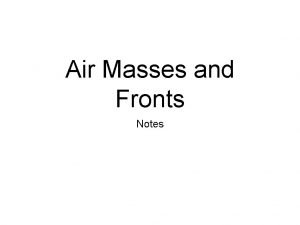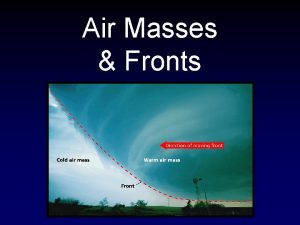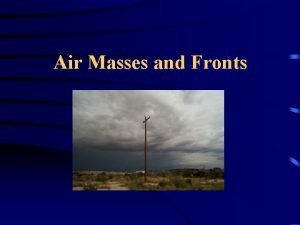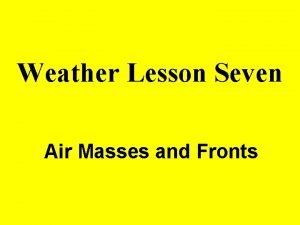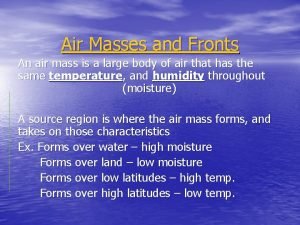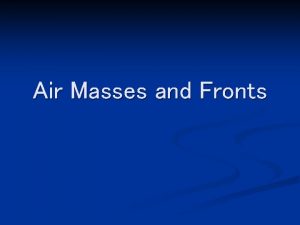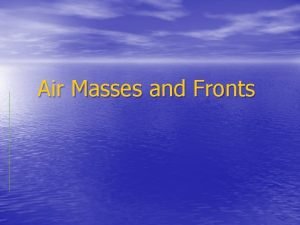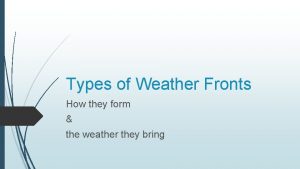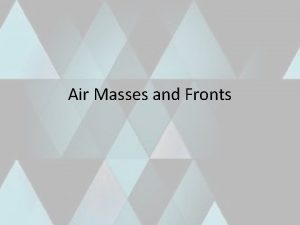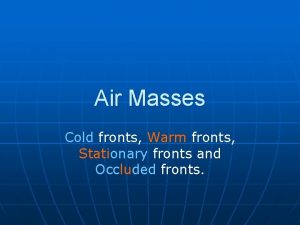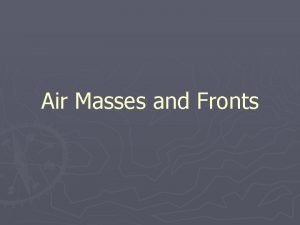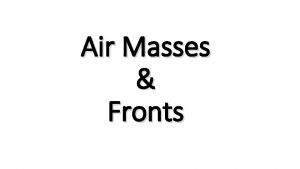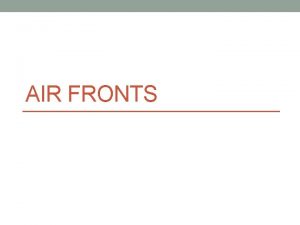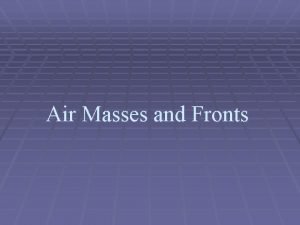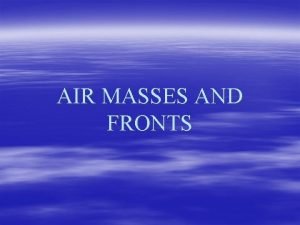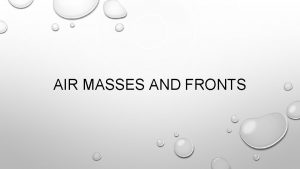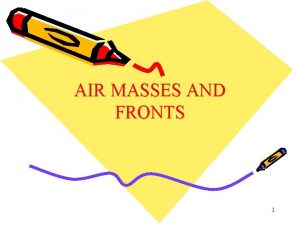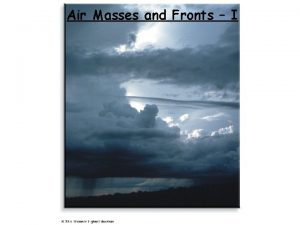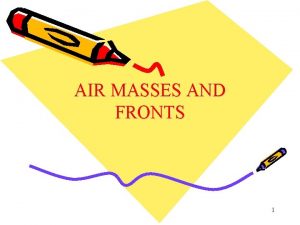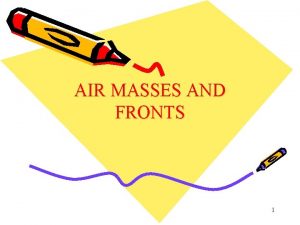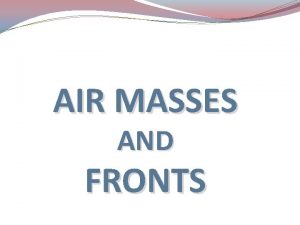Air Masses and Fronts Chapter 17 Section 1
















- Slides: 16

Air Masses and Fronts Chapter 17 Section 1

Air Masses and Fronts n Today’s weather can be influence by air from thousands of kilometers away n A huge body of air that has similar temperature, humidity, and air pressure at any given height is called an air mass n A single air mass may spread over millions of square kilometers and be up to 10 kilometers deep

Types of Air Masses n Scientists classify air masses according to temperature and humidity n Four major types of air masses influence the weather in North America: maritime tropical, continental tropical, maritime polar, and continental polar n Recall: Temperature affects air pressure

Types of Air Masses n n Cold, dense air has a high pressure, while warm, less dense air has a lower pressure Tropical, or warm, air masses from in the tropics and have low air pressure Polar, or cold, air masses form north of 50° north latitude and south of 50 ° south latitude Maritime air masses form over oceans n n Typically very humid air Continental form over land n Typically drier air

Maritime Tropical Warm, humid air masses form over the tropical oceans n In summer, typically bring hot, humid weather n Many summer showers and thunderstorms in Eastern United States caused by this n In winter, humid air mass can bring heavy rain/snow n

Maritime Polar n Cool, humid air masses form over the icy cold North Pacific and North Atlantic oceans n Affect West Coast more than East coast n Typically bring fog, rain and cool temperatures to the West in summer

Continental Tropical n Hot, dry air masses form mostly in summer over dry areas of the Southwest and Northern Mexico n Cover a smaller area than other air masses n Move Northeast bringing hot, dry air to the Great Plains

Continental Polar Large continental polar air masses form over central and northern Canada and Alaska n Bring bitterly cold weather with very low humidity n Bring cold, clear, dry air to much of North America in the winter n Storms may occur when continental polar air masses move south and collide with maritime tropical air masses moving north n


Types of Fronts Air masses are commonly moved by the prevailing westerlies and jet streams in the US n Colliding air masses can form four types of fronts: cold fronts, warm fronts, stationary fronts, and occluded fronts n Type is determined by the characteristic of the air masses and how they are moving n

Cold Fronts Occurs when a rapidly moving cold air mass runs into a slowly moving warm air mass n Since cold fronts move quickly, they can cause abrupt weather changes, including thunderstorms, clouds, and precipitation n After a cold front moves through, colder, drier air often moves in along with clear skies, a shift in wind, and lower temperatures n

Warm Fronts A fast moving warm air mass takes over a slow moving cold air mass n If warm air is humid, light rain or snow will fall n If warm air is dry, scattered clouds form n B/c warm fronts move slowly, it may be rainy or cloudy for several days n After a warm front moves through, the weather is likely to be warm and humid n

Stationary Front Occurs when warm and cold air masses meet, but neither one can move the other n Where the warm and cool air meet, water vapor in the warm air condenses into rain, snow, fog, or clouds n If it stays stalled over an area, it may bring many days of clouds and precipitation n

Occluded Front Most complex weather situation n Warm air mass gets caught between two cold air masses n Two cold air masses mix and the warm air mass is cut off n Becomes cooler or cold on the ground n

Cyclones The L on a weather map stands for “low” and indicates an area of relatively low air pressure n A swirling center of low air pressure is called a cyclone n Cyclones play a large part in the weather of the US n Cyclones and decreasing air pressure associated with clouds, wind, and precipitation n

Anticyclones n Opposite of a cyclone----high pressure centers of dry air n Marked on a weather map with an H n The descending air in an anticyclone generally causes dry, clear weather
 Air masses and fronts
Air masses and fronts Air masses notes
Air masses notes North american air masses
North american air masses Air masses in north america
Air masses in north america Two cold air masses converge on a warm air mass
Two cold air masses converge on a warm air mass Whats an air mass
Whats an air mass Air masses & frontswhat is an air mass?
Air masses & frontswhat is an air mass? Maritime tropical air mass symbol
Maritime tropical air mass symbol Air mass vocabulary
Air mass vocabulary Air masses & frontswhat is an air mass?
Air masses & frontswhat is an air mass? Air masses & frontswhat is an air mass?
Air masses & frontswhat is an air mass? Air masses & frontswhat is an air mass?
Air masses & frontswhat is an air mass? Warm front drawing
Warm front drawing Types of air masses
Types of air masses Section 1: what causes air pollution answer key
Section 1: what causes air pollution answer key Chapter 12 air section 1 what causes air pollution
Chapter 12 air section 1 what causes air pollution Characteristics of fronts
Characteristics of fronts

